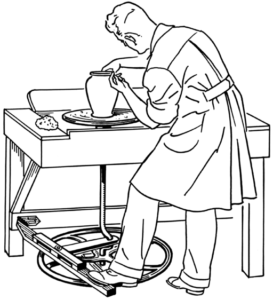Most entrepreneurs begin their start-up with a picture of a perfect product rather than an MVP. It solves huge problems and people gladly pay significant funds to obtain it. This product perfection is smooth, clean, and filled with features that appeal to every demographic and better lives.
If you are very lucky that perfect product will be something you will end up with eventually, but it probably won’t be possible for years and only after constant testing and iterating. Instead of seeking perfection from the outset, you should begin with a Minimum Viable Product (MVP). While your MVP won’t look like the product you have in your head, it is the most valuable part of your product design process. If you design and test your MVP correctly, you will build a sound foundation for your business and that perfect product.

Clear Your Mind
The first step in building an MVP might actually be the hardest. Entrepreneurs are creators who are motivated by making their idea a reality. These concepts are generally complex, nuanced, and “perfect.” But complex and nuanced is rarely perfect, and never on the first try.
What is possible is doing one thing simply, quickly, and well and to use that product to make sure that you are creating something that people need. This product will not be able to solve all problems, but it should be able to address an issue that is a pain point for a group of individuals that would be willing to pay for a solution.
“Human nature has a tendency to admire complexity, but to reward simplicity,” said Brad Fell, co-founder of the incubator TechStars. “The more complicated you make your business, the harder it is to expand it. So stick with proven solutions and keep it simple. You may have to give up a few features here and there, but you’ll be more nimble as a company.”
When you look at the transformative entrepreneurs, like Steve Jobs, they all preach simplicity. But simplicity doesn’t mean lack of quality. Focus on doing the simple things really well. Identify and develop for a smaller group of customers at first, but make sure that their experiences with your products are unforgettable. This mindset sets you up to achieve early successes, which will motivate you for the iteration process.

Identify Your #1 Problem
Once you have committed yourself to doing simple well, it is time to identify the problem your product is going to solve. This step is crucial, because how well you solve the problem you choose will be how your product and your business is judged.
Steve Blank, the author of Lean Startup, advocates that entrepreneurs focus on the simplest problem customers have that would be willing to pay to have solved. This runs counter to what many salespersons and marketers want to do; marketers think the more features you have the larger the pool of potential customers.
The marketer’s approach divides your attention and decreases the possibility that you will be able to provide an exceptional experience for your target customer. There will always be room for growth later; by focusing on smaller more attainable goals you can create a company that is defined by excellence and attention to detail, which will make expanding your market easier in the long-run.
Identifying your target problem is simple. Find representatives of the customers you want to reach and ask them what their problems are. Don’t ask what they want to solve those problems; they will provide you with a long list of features that will make it hard for you to keep it simple. A few problems will come up routinely. Pick the easiest to solve and begin your design process.

Design Your MVP
When you are first starting out, you need to build a low-fidelity MVP and focus on validating the MVP. (We’ll discuss high-fidelity MVPs and when to use those later in the series). A low-fidelity MVP is meant to test one thing; are you solving a problem with a service for which customers will pay? It is meant to test whether you identified the right “number 1 problem” for your business. As we discussed in the last post, there are several different types of low-fidelity MVP. But each type of MVP needs to do a few things.
First, you need to be able to measure responses. It is not enough to build something and see if people say they like it or if they visit your website. You need a metric that will provide evidence, one way or the other, regarding your product’s “fit” with your target market.
Second, your low-fidelity MVP needs to provide you with feedback outside the target metric you are evaluating. This MVP testing techniques will lead to better iterations in the future. If many of your customers are clamouring for a feature or asking you to use your product to address another problem, you will know what your next step in the development process will be.
Finally, you need to develop your low-fidelity MVP as quickly and as cheaply as possible while still achieving the top two goals. Many entrepreneurs set out to build their prototype first and use that as their MVP. But building a prototype can be expensive, time consuming, and emotionally devastating if you do not get the results you are expecting. By developing an inexpensive MVP that you are not as emotionally invested in, if you get new information that reveals an alternative approach to what you were considering you can easily pivot.
Some common examples of low-fidelity MVPs include landing pages, surveys, powerpoint presentations, and design mockups. All of these require little in the way of coding or development, but if done correctly can provide the basics of what problem you are going to solve and why it is important to your customers.
The goal of this MVP is for your customers to take an action to affirm that they are interested in your concept. Possible actions include getting potential customers to submit their email address so you can keep them apprised of your product’s development to getting them to prepay for your product when it becomes available.The goal is for low-fidelity MVP to get the customer to make some sort of commitment to you and your company; the more commitments you get, the more likely your product is a winner.

Test Your MVP and Iterate
Testing and iterating comes down to one thing; finding the balance between being responsive to what you learn but not overreacting and losing your unique value proposition. That means that a lot of times your response to testing shouldn’t be to add, but to subtract. Here are a few different responses your MVP will get during testing and how to interpret it.
- You receive a ton of complaints from your users. This is a good thing. If your users are not complaining, they aren’t invested in what you are doing and wouldn’t try to make it better. Complaints reveal passion and an interest in making your product better..
- Your customers are disinterested. If you are convinced that this is the market you want to target, but these customers you are testing do not engage your MVP the way you like, you have two choices. You either need to leave the building and find a market that will appreciate your MVP as it is or design a better MVP for the original marketing audience.
- You get a lot of feedback and requests for new features. This is especially dangerous for entrepreneurs because their instinct is to build. But more features distract from your unique selling proposition, which is why people come to you in the first place. In the early days especially focus on the one facet of your product that keep people coming back. Keep a list of the potential features to revisit after you have perfected your one core feature.
The purpose of an MVP is not to optimise your product, but rather to learn about your customers. If you make them happy, your company will be successful. Focus on them, give them what they need, and you will build that perfect product – even if it doesn’t look like what you thought it would in the beginning.